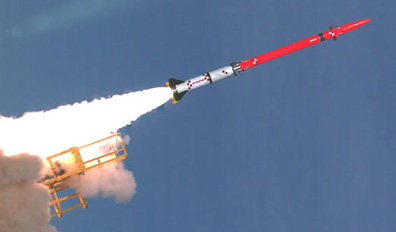After half a century of service, and numerous upgrades, the Israeli air force is finally considering phasing out the Raytheon MIM-23 Hawk surface-to-air missiles, replacing it with with David’s Sling, an air defense missile system being developed in Israel and the U.S., by a joint venture between Raytheon and Rafael Advances Defense Systems. Israel has 17 operational batteries of MIM-23B Improved Hawk missiles. Each battery has three launchers carrying three missiles each. Each David’s Sling launcher holds 16 missiles. The battery also relies on a complex network of target acquisition, tracking and guidance radars. Davis’d sling can be operated with networked, distributed assets, relying on two multi-role phased-array radars and command section, supporting a number of fire units.
According to Israeli news sources, the Israel Air Force is expecting to receive the first elements of a David’s Sling unit in 2012, and deploy the new systems in a phased program in the following years. David Sling is being developed as part of the country’s multi-layered air and missile defense system, comprising the Iron Dome and David’s Sling, designed to intercept short and medium range rockets, and Arrow II and Arrow III, tasked against ballistic missile threats. David’s Sling will also provide secondary air defense capability, alongside the Raytheon MIM-104 Patriot air defense missiles.
David’s Sling employs the new Stunner interceptor missile developed by Rafael. According to company sources, the Stunner, currently undergoing flight testing, will introduce new capabilities in terms of maneuverability, range and versatility, as it was designed to defeat both air breathing (aircraft/cruise missiles) and maneuvering or ballistic threats (missiles, long range rockets), thus combining high speed, long range and end-game maneuverability. The original requirement of the Israel Ministry of Defense was for a missile capable of defeating ballistic missiles and rockets launched from ranges of 70 – 300 km. Among the missiles falling under this category are the Iranian/Syrian M600, Zelzal, Fajr and Fateh 110, all are deployed with Hezbollah in Lebanon.
In addition to the advanced rocket motor, the missile uses an unique multi-modal seeker providing the missile superior counter-countermeasures, all-weather capability and maintains precision aim-point selection at end-game. The built-in datalink communications enables the missile to receive targeting updates and retasking in flight while the warhead is uniquely designed to destroy the wide target set it was designed to defeat. The Stunner was designed from the baseline to be used as an air/air missile, sized and weighed for internal carriage inside the F-35 weapon’s bay. However, the cooperation agreement between Rafael and Raytheon is yet to cover this application.
The integration of David’s Sling into the nation-wide multi-layered missile defense system represents a departure from current air defense network, whereas the ‘active defense’ component will have to ‘coexist’ with military and civil aviation airspace, rather than control restricted airspaces. To enable such integration, Rafael is developing an integrated command and control center that integrating the ‘air picture’ of friendly and hostile aircraft, threat missile tracks, and feed from the airspace management system, developing full situation control for managing and allocating targets for multiple units, operating different types of missiles (Iron Dome, David’s Sling or other assets). Rafael will demonstrate this new concept and the David’s Sling, at the Paris Air Show next month.


















